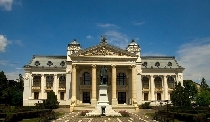
Western Romanias region of Banat is a multiethnic and multicultural region.

Along the year Peles Castle has been a landmark of the Romanian House

The myth of the vampire-count Dracula has made Romania known to the West.

Known for its ancient traditions and pristine landscapes, the northern region of Maramures is also the ideal location for monasteries and hermitages.

A venue with a long tradition for the academic world.

The consolidation of the modern Romanian state began in 1866. On April 1st the same year, the future Romanian Academy was established.

Sarmiza Bilcescu was Romania's first female lawyer and also the first woman to get a doctoral degree from the University of Sorbonne.

Alba Iulia has been a major cultural and historical centre for centuries.

Romanian Academy Library launches new website containing electronic copies of scores of Romanian medieval manuscripts.

The foundation of the museum is closely linked to Transylvanias union with the Kingdom of Romania.

The helicopter is considered to be the invention of one of the worlds most brilliant minds, the Florentine artist of the Renaissance, Leonardo da Vinci.

A feature on one of the best-known Romanian writers in Paris in the early 20th century.

The Dalles Foundation is a place Bucharesters are very familiar with.

2016 is for the theatre world in Iasi a year full of anniversaries.

The Maria Radna monastery in Lipova, Western Romania, was a well-known place even to Pope John Paul 2nd.
